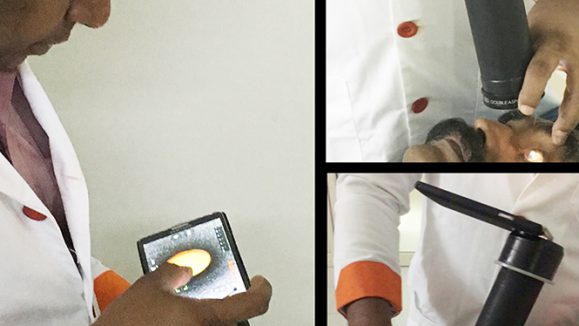Age-related macular degeneration (AMD) and diabetic macular edema (DME) are heterogenous diseases that require an individualized treatment approach. In a recent Cybersight webinar, Dr. Arghavan Almony from North Carolina, USA, looked into novel and upcoming therapies that promise to reduce treatment burden for these diseases.
Macular degeneration is the leading cause of severe and irreversible visual loss worldwide, affecting about 8.7% of the global population. “The disease has a profound effect on the quality of life of not only the affected individuals but their loved ones as well. It represents a major socio-economic challenge for societies, due to the exponential increase in life expectancy, as well as environmental risks,” shared Dr. Almony.
Meanwhile, DME affects about 21 million people worldwide, and advanced diabetic retinopathy (DR) is a significant risk factor for sustained blindness, she added.
An ounce of prevention is worth a pound of cure
According to Dr. Almony, there’s currently no treatment for dry macular degeneration, and prevention is recommended. The latter includes self-monitoring, eating a nutrient-dense diet, taking age-related eye disease study (AREDS2) vitamins, smoking cessation, and having regular eye exams.
As for wet macular degeneration, anti-vascular endothelial growth factor (anti-VEGF) injections are the gold standard. “Since macular degeneration is a heterogeneous disease, it requires an individualized approach. We know that 10% to 20% of patients require injections every four weeks, and another 10% to 20% require injections every 10 to 12 weeks. Others fall in between those two groups.
And as for DME, there are multiple treatment options, which include anti-VEGF injections, laser photocoagulation, corticosteroids, and pars plana vitrectomy in certain cases.
Challenges in anti-VEGF therapy
Even though intravitreal anti-VEGF therapies are the go-to treatments for both neovascular AMD (nAMD) and DME, they bring about a significant treatment burden.
“The burden of disease has turned into a burden of care,” shared Dr. Almony. “We know that anti-VEGFs are effective in reducing macular edema, reducing neovascularization, and ultimately improving or stabilizing sight.”
Unfortunately, frequent intravitreal injections are a burden for patients and their caregivers. Appointments for monitoring and injections are regular events that patients plan their lives around. Collectively, anti-VEGF therapy creates financial strain for both patients and caregivers.
“While AMD patients are usually retired and rely on caregivers to transport them for clinic visits, DME patients are typically working full-time and have to take time off their jobs in order to receive treatment,” said Dr. Almony.
She shared that a study done on 75 patients with nAMD found that the mean time per visit, including preparation, travel, waiting, treatment, and recovery time from the injections, was almost 12 hours per patient.
“We also know that real-world experiences have been different compared with clinical trials,” she continued. “Real-world patients with nAMD or DME have been found to receive fewer injections and experience worse visual outcomes compared to [those in] clinical trials. Older patients and patients with poor baseline visual acuity are more likely to be under-treated.”
“Hence, the need for longer-lasting therapies is definitely at the top of the list. We also want new drug pathways beyond anti-VEGF, as well as non-invasive therapies,” she said, referring to the American Society of Retina Specialists PAT Survey 2021 on the greatest unmet needs regarding wet AMD treatment.
Exciting new therapies in the retinal pipeline
Thankfully, promising novel therapies are on the horizon, offering hope for reducing treatment burden. Firstly is the dual-targeted therapy that targets multiple underlying causes of DME and nAMD by combining two medications, noted Dr. Almony.
The dual-targeted therapy has the potential benefits of improved visual and anatomic outcomes, fewer injections and office visits, reduced anxiety and depression, and increased productivity.
“Faricimab (VABYSMO) is the latest drug available under this dual mechanism segment. The Faricimab molecule has an arm that binds to Ang-2 to reduce inflammation and vascular leakage, and another arm that binds to VEGF-A, inhibiting vascular leakage and neovascularization at the same time,” explained Dr. Almony. “It also has an inactivated region that is engineered to reduce systemic exposure and inflammatory potential. Through a novel mechanism of action, it is designed to stabilize blood vessels and reduce inflammation and leakage more than either pathway alone” she noted, adding that faricimab is the first bispecific immunoglobulin-based antibody designed for the eye approved by the US Food and Drug Administration (FDA) in October 2021.
Backed by clinical trials
Further, Dr. Almony mentioned that clinical trials have looked at the safety, durability, and efficacy of faricimab for nAMD and DME. “The TENAYA and LUCERNE trials compared faricimab with aflibercept in about 1,300 patients with AMD and found that faricimab has non-inferior vision gains to aflibercept at week 48. More than 50% of faricimab patients were treated every 16 weeks, rather than every eight weeks. And more than 75% of faricimab patients were treated every 12 weeks, rather than eight weeks. Faricimab seems to be a direct answer to the need for longer-lasting therapies,” she shared.
“It is generally well-tolerated, with no new safety signals. And what’s really important is that faricimab is the first new class of medications that is effective for wet AMD in over 15 years,” Dr. Almony added.
Similar trials were performed for DME — the YOSEMITE and RHINE trials. “Again, we saw non-inferior vision gains when compared with aflibercept. More than 50% of faricimab patients were treated every 16 weeks versus every eight weeks with aflibercept. This was the first investigational drug to achieve this level of durability, which is very exciting for our patients,” she said.
When using VABYSMO for nAMD, Dr. Almony advised physicians to start with four monthly loading doses, followed by Q4 to Q16 weekly dosing, depending on the patient’s optical coherence tomography (OCT) result and visual acuity.
For diabetic macular edema, there are two options. Physicians can begin with four monthly loading doses or six monthly loading doses, followed by incremental extension or reduction, or intervals of every eight weeks.
She also mentioned that there is an upcoming inhibitor of VEGF-C and VEGF-D in the form of combination drug OPT-302. It is not yet available and studies are ongoing.
Other novel treatment options for wet AMD and DME
Meanwhile, the newest options in the US for wet AMD and DME are biosimilars, products that are highly similar (but not identical) to the originator biologic (an FDA-approved product). These products have actually been available in other parts of the world for seven to eight years. Dr. Almony noted that the number of biosimilars across different medical specialties is increasing. There are now a total of 30 FDA-approved biosimilars representing 10 distinct reference products.
“The first ranibizumab biosimilar entered the US market this year. And the first aflibercept biosimilar is expected to enter the market in 2024,” she said.
An interesting drug currently under development as an investigational ophthalmic formulation of bevacizumab is Lytenava. If approved, it will be the first and only FDA-approved, on-label bevacizumab approved for the treatment of wet AMD and potentially for DME.
In addition, a number of molecules are under investigation for the treatment of geographic atrophy (GA), such as avacincaptad pegol, which prevents the proinflammatory effects of C5a and cell lysis and damage on RPE cells by MAC (C5b-9). The GATHER1 trial found that the GA growth rate was reduced by about 27% when avacincaptad pegol 2 mg was used compared to sham, and 28% when 4 mg was used.
Last but not least, there is the SUSVIMO (ranibizumab injection), a refillable intraocular implant at the pars plana for the customization of ranibizumab treatment. Refill-exchange procedures are performed in the office approximately every six months. However, there are concerns about septum dislodgement, and the product had undergone voluntary recall in October 2022.
Editor’s Note: The Cybersight webinar The Therapeutic Pipeline for Age-Related Macular Degeneration and Diabetic Macular Edema: Where Do We Stand and Where Are We Headed? by Dr. Arghavan Almony was held on December 9, 2022. Reporting for this story took place during the event. A version of this article was first published in PIE magazine Issue 25.



